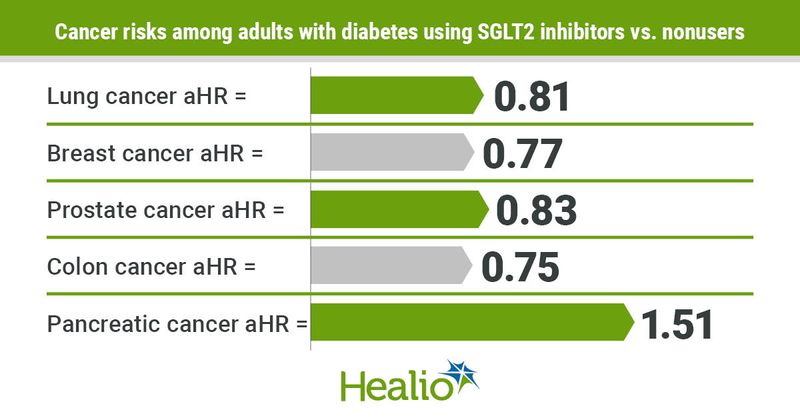SGLT2 inhibitors may reduce cancer risks among adults with diabetes
Key takeaways:
- Adults with diabetes using SGLT2 inhibitors have lower risks for developing cancers than those who do not use the drugs.
- Cancer risks decrease with longer duration of SGLT2 inhibitor use.
Adults with diabetes who use SGLT2 inhibitors have lower risks for developing most types of cancer compared with nonusers, though the risk for pancreatic cancer is higher among SGLT2 users, according to data from researchers in Taiwan.
“Recently, novel antidiabetic agents with SGLT2 inhibitors were introduced and several pluripotent effects were proposed,” Wei-Syun Hu, MD, PhD, assistant professor of medicine at China Medical University and attending physician of cardiovascular medicine at China Medical University Hospital in Taiwan, and colleagues wrote in a study published in the Journal of Diabetes and Its Complications. “In this regard, to identify the role of pharmacologic intervention in incident cancer among diabetic individuals is truly novel and interesting and clearly of importance for health care delivery and quality control efforts. Therefore, this study was conducted for evaluation of the relation between SGLT2 inhibitors and risk of incident cancer among patients with diabetes.”

Researchers collected data from the National Health Insurance database in Taiwan of 325,990 adults with diabetes using an SGLT2 inhibitor between 2016 and 2019 (57.8% men; mean age, 58.5 years). The SGLT2 inhibitor group was matched by age and sex with a group of 325,989 adults with diabetes who did not use an SGLT2 inhibitor. The occurrence of cancer was the primary outcome. Researchers also analyzed associations between SGLT2 inhibitor use and specific cancer types. Baseline comorbidities and other medication use were also collected.
Adults receiving SGLT2 inhibitors had a lower risk for developing cancer than those who did not use SGLT2s (adjusted HR = 0.79; 95% CI, 0.76-0.83). Among the full cohort, men had a higher risk for developing cancer than women (aHR = 1.35; 95% CI, 1.3-1.41) and adults aged 50 to 64 years (aHR = 2.47; 95% CI, 2.3-2.66) and aged 65 years and older (aHR = 4.31; 95% CI, 3.99-4.65) were more likely to develop cancer than adults aged 49 years and younger.
When specific cancer types were analyzed, SGLT2 inhibitor use was associated with a reduced risk for tongue cancer (aHR = 0.61; 95% CI, 0.45-0.84), oral cavity cancer (aHR = 0.54; 95% CI, 0.41-0.72), esophagus cancer (aHR = 0.48; 95% CI, 0.34-0.68), colon cancer (aHR = 0.75; 95% CI, 0.66-0.84), liver cancer (aHR = 0.79; 95% CI, 0.7-0.88), lung cancer (aHR = 0.81; 95% CI, 0.72-0.92), breast cancer (aHR = 0.77; 95% CI, 0.66-0.9), prostate cancer (aHR = 0.83; 95% CI, 0.7-0.99), bladder and kidney cancer (aHR = 0.72; 95% CI, 0.6-0.87) and thyroid cancer (aHR = 0.67; 95% CI, 0.5-0.89). However, those using SGLT2 inhibitors had a higher risk for pancreatic cancer than non-SGLT2 users (aHR = 1.51; 95% CI, 1.22-1.87).
“This novel finding might be reasonable since elevated risk of pancreatitis among the usage of SGLT2 inhibitor was once proposed,” the researchers wrote about the higher pancreatic cancer risk with SGLT2 use. “Such trend further consolidated our hypothesis and definitely deserved further investigation to redefined.”
Adults who used an SGLT2 inhibitor for less than 60 days (aHR = 1.68; 95% CI, 1.59-1.78) or 60 to 140 days (aHR = 1.3; 95% CI, 1.21-1.39) were more likely to develop cancer than those who did not use SGLT2s. The risk for developing cancer was lower for adults using an SGLT2 inhibitor for 140 to 280 days (aHR = 0.73; 95% CI, 0.68-0.78) or more than 280 days (aHR = 0.26; 95% CI, 0.23-0.28) compared with nonusers.
“Some might argue that all cancers could be reduced by almost 27% within 140 to 280 days of SGLT2 inhibitor exposure and even could be reduced by 74% above 280 days usage of SGLT2 inhibitor,” the researchers wrote. “The observational study is hard to address the detailed mechanism underling the observation. Nonetheless, the trend is clear and based upon a well validated nationwide dataset. Further prospective mechanism exploring research is necessary."
